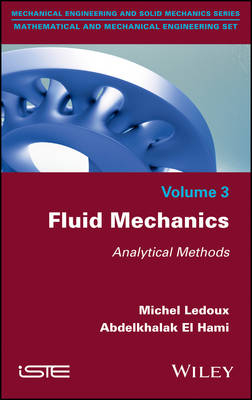
Fluid Mechanics
ISTE Ltd and John Wiley & Sons Inc (Verlag)
978-1-84821-951-9 (ISBN)
Michel Ledoux is Professeur des universit??s. He was formerly Vice- President for Research at the University of Rouen in France, then Regional Delegate for the Ministry of Education in the region of High Normandy for Research and Technology. He is now retired from University, but is Counselor at the Conservatoire de Arts et M??tiers in Normandy and still teaches physics to apprentice-engineers (Cnam and ITII). He was involved in reacting flows and spray systems research. Abdelkhalak El Hami is Professeur des universit??s at the Institut National des Sciences Appliqu??es (INSA-Rouen) in France and is in charge of the Normandy Conservatoire National des Arts et Metiers (CNAM) Chair of Mechanics, as well as several European pedagogical projects. He is an expert in fluid-structure interaction studies and reliability.
Preface ix
Chapter 1. Mechanics and Fluid 1
1.1. Introduction 1
1.1.1. Mechanics: what to remember 1
1.1.2. Momentum theorem 4
1.1.3. Kinetic energy theorem 5
1.1.4. Forces deriving from a potential 6
1.1.5. Conserving the energy of a material point 8
1.2. The “fluid state” 9
1.2.1. Fluid properties 9
1.2.2. Forces applied to a fluid 12
1.3. How to broach a question in fluid mechanics 22
1.3.1. The different approaches of fluid mechanics 22
1.3.2. Strategies for arriving at a reasoned solution 23
1.4. Conclusion 25
Chapter 2. Immobile Fluid 27
2.1. Introduction 27
2.1.1. The fundamental theorem of fluid statics 27
2.2. Determining the interface position and related questions 30
2.2.1. Fluid statics. Incompressible fluids subject to gravity 30
2.2.2. Case of volume forces deriving from a potential 43
2.2.3. Case for compressible fluids 51
2.3. Calculating the thrusts 57
2.3.1. Methods 57
2.3.2. Thrusts on bodies that are totally immersed in incompressible fluids 58
2.3.3. Calculating the thrust on a wall 79
Chapter 3. A Description of Flows 87
3.1. Introduction 87
3.2. The description of a fluid flow 88
3.2.1. The Eulerian and Lagrangian description 88
3.2.2. Kinematic elements 91
3.2. A first principle of physics: the principle of continuity 96
3.2.1. The principle of continuity 96
3.3. Notions and recalls on potential flows 102
3.3.1. Definition 102
3.3.2. Determination 102
3.3.3. Determining streamlines 104
3.3.4. Curl of the velocity 104
3.4. Example of kinematic calculations 105
Chapter 4. Dynamics of Inviscid Fluids 127
4.1. Introduction 127
4.2. The Bernoulli theorem: proof 127
4.2.1. What to retain 133
4.2.2. Energetic interpretation of the Bernoulli theorem 134
4.2.3. Physical interpretation of the Bernoulli theorem 135
4.2.4. “Constant energy” flows 135
4.3. Applications of the Bernoulli theorem 136
4.3.1. Methodology for the resolution of a problem using the Bernoulli theorem 136
4.3.2. Determining an applicate 145
4.3.3. Draining and filling 150
4.3.4. Mobile reference frame 157
4.3.5. Time-dependent filling 168
4.4. Draining of the ballasts 177
4.5. Synthetic problems 179
Chapter 5. Viscous Fluid Flows: Calculating Head Losses 197
5.1. Introduction 197
5.2. The notion of head: generalized heads 198
5.3. Practical calculation of a head loss 200
5.3.1. Introduction 200
5.3.2. Linear head losses 201
5.3.3. Singular loss of head 203
5.4. Circuit calculations 205
Chapter 6. Calculation of Thrust and Propulsion 235
6.1. Introduction 235
6.2. Euler’s theorem and proof 235
6.2.1. Euler’s first theorem and proof 236
6.3. Thrust of a jet propulsion system, and propulsive efficiency 240
6.3.1. Calculation of the thrust of an “airplane engine” 240
6.3.2. Calculation of the propulsive efficiency 244
6.3.3. Calculation of the thrust of a rocket engine 246
6.3.4. Some applications of Euler’s theorem to jet propulsion 247
6.4. Thrust exerted by a jet on a fixed wall 263
6.4.1. Calculation of the thrust applied to a wall by a jet 263
6.4.2. Jet impacting on a wall 266
6.5. Other applications for Euler’s theorems 272
6.5.1. Application of Euler’s theorem to a head loss calculation 272
6.5.2. A case for the application of Euler’s second theorem 277
Bibliography 283
Index 285
| Erscheinungsdatum | 20.01.2017 |
|---|---|
| Verlagsort | London |
| Sprache | englisch |
| Maße | 163 x 239 mm |
| Gewicht | 590 g |
| Themenwelt | Technik ► Maschinenbau |
| ISBN-10 | 1-84821-951-2 / 1848219512 |
| ISBN-13 | 978-1-84821-951-9 / 9781848219519 |
| Zustand | Neuware |
| Haben Sie eine Frage zum Produkt? |
aus dem Bereich


